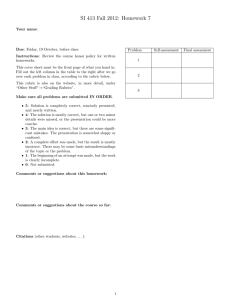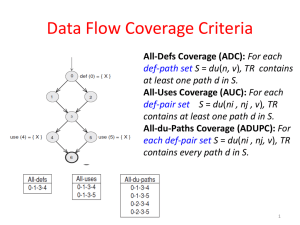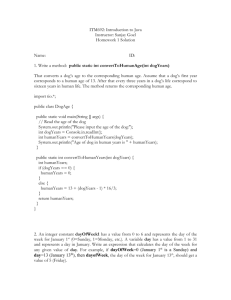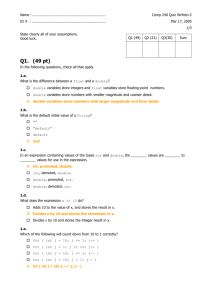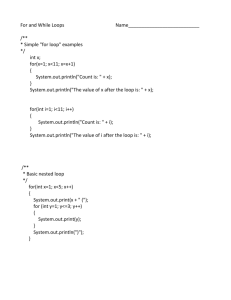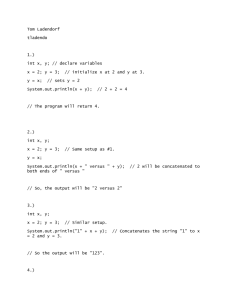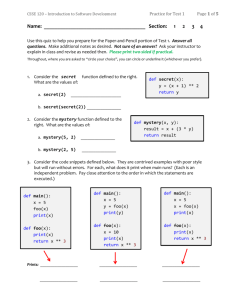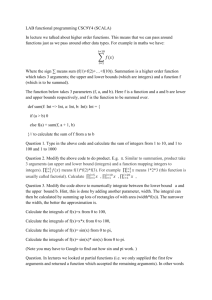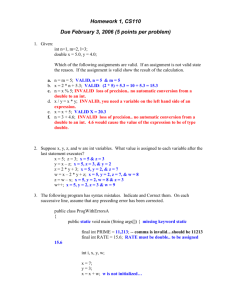3, 4, 3, 5, 6, 7, 6, 8
advertisement
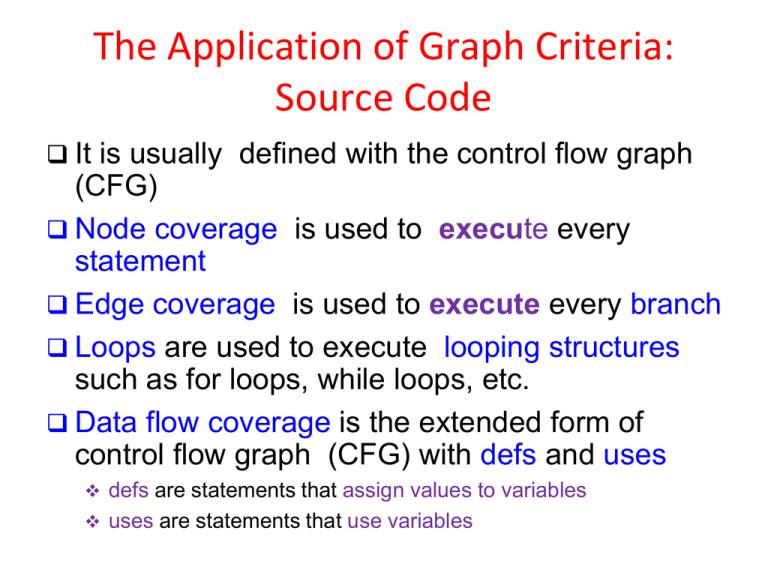
The Application of Graph Criteria:
Source Code
It is usually defined with the control flow graph
(CFG)
Node coverage is used to execute every
statement
Edge coverage is used to execute every branch
Loops are used to execute looping structures
such as for loops, while loops, etc.
Data flow coverage is the extended form of
control flow graph (CFG) with defs and uses
defs are statements that assign values to variables
uses are statements that use variables
Tests with Data Flow Criteria
Data flow criteria require tests that tour
subpaths from specific definitions of variables
to specific uses
Nodes where a variable is assigned a value
are called definitions (or defs)
Nodes where the value of a variable is
accessed are called uses.
Data Flow Coverage for Source
def : A location where a value is stored into memory
x appears on the left side of an assignment (x = 44;
x is an actual parameter in a call and the method changes its value
x is a formal parameter of a method (implicit def when method
starts)
x is an input to a program
use : A location where variable’s value is accessed
x appears on the right side of an assignment
x appears in a conditional test
x is an actual parameter to a method
x is an output of the program
x is an output of a method in a return statement
If a def and a use appear on the same node, then it is only a
DU-pair if the def occurs after the use and the node is in a
loop
3
A definition d for a variable x reaches a use u if
there is a path from d to u that has no other
definitions of x (def-clear).
The all-uses (AU) criterion requires tests to tour
at least one subpath from each definition to
each reachable use.
// EXAMPLE: return index of the last element in x that equals y.
// if y is not in x, return -1.
public int findLast (int []x, int y)
{
for (int i = x.length-1; i>=0; i--)
{
if (x[i] == y)
return i;
} return -1;
Annotated Control Graph
Nodes 4 and 6 are final
nodes, corresponding to
the return statements.
Node 2 is introduced to
capture the for loop; it
has no executable
use(3)=
statements.
DU (def-use) pairs are
shown as a variable
name followed by the def
node, then the use node.
def (5) = { i }
use (5) = { i }
Def -Use Pairs = { (1, 1,x), (1,3,x), (1,3,y), (1, 2,i), (1, 3,i),
(1,5,i), (1,6,i), (5, 2,i), (5, 3,i), ( 5, 6,i), (5, 5,i)}
public static void computeStats (int [ ] numbers)
{
int length = numbers.length;
double med, var, sd, mean, sum, varsum;
sum = 0;
for (int i = 0; i < length; i++)
{
sum += numbers [ i ];
}
med = numbers [ length / 2];
mean = sum / (double) length;
1
2
i=0
3
varsum = 0;
for (int i = 0; i < length; i++)
4
{
5
varsum = varsum + ((numbers [ I ] - mean) * (numbers [ I ] - mean));
i=0
}
var = varsum / ( length - 1.0 );
sd = Math.sqrt ( var );
6
System.out.println ("length:
" + length);
i < length
System.out.println ("mean:
" + mean);
i >= length
System.out.println ("median:
" + med);
7
System.out.println ("variance:
" + var);
8
System.out.println ("standard deviation: " + sd); }
i++
6
Edge Coverage
1
TR = {[ 1, 2 ],[ 2, 3 ],[ 3, 4 ],
[ 3, 5 ], [ 4, 3 ], [ 5, 6 ],
[ 6, 7 ], [ 6, 8 ],[ 7, 6 ]}
2
3
4
5
Test Path , 3,
4, 3, 5, 6, 7, 6, 8 ]
[ 1, 2, 3,4, 3, 5, 6, 7, 6, 8] ]
6
7
8
7
Edge-Pair Coverage
TR={ [ 1, 2, 3 ], [ 2, 3, 4 ], [ 2, 3, 5 ], [ 3, 4, 3 ],
[ 3, 5, 6 ], [ 4, 3, 5 ],[ 5, 6, 7 ],[ 5, 6, 8 ],
[ 6, 7, 6 ], [ 7, 6, 8 ], [ 4, 3, 4 ], [ 7, 6, 7 ]}
Test Paths
i.[ 1, 2, 3, 4, 3, 5, 6, 7, 6, 8 ]
ii. [ 1, 2, 3, 5, 6, 8 ]
iii. [ 1, 2, 3, 4, 3, 4, 3, 5, 6, 7, 6, 7, 6, 8 ]
Test Requirements Toured
i.[ 1, 2, 3 ], [ 2, 3, 4 ], [ 3, 4, 3 ], [ 3, 5, 6 ], [ 4, 3, 5 ],
[ 5, 6, 7] , [ 6, 7, 6 ], [ 7, 6, 8 ]
ii. [ 1, 2, 3 ], [ 2, 3, 5 ], [ 3, 5, 6 ], [ 5, 6, 8 ]
iii. [ 1, 2, 3 ], [ 2, 3, 4 ], [ 3, 4, 3 ], [ 3, 5, 6 ],
[ 4, 3, 5 ], [ 5, 6, 7 ],[ 6, 7, 6 ],[ 7, 6, 8 ],
[ 4, 3, 4 ], [ 7, 6, 7 ]
8
Prime Path Coverage
TR={ [ 3, 4, 3 ],[ 4, 3, 4 ],[ 7, 6, 7 ], [ 7, 6, 8 ],
[ 6, 7, 6 ], [ 1, 2, 3, 4 ], [ 4, 3, 5, 6, 7 ],
[ 4, 3, 5, 6, 8 ], [ 1, 2, 3, 5, 6, 7 ], [ 1, 2, 3, 5, 6, 8 ]}
Test Paths
i. [ 1, 2, 3, 4, 3, 5, 6, 7, 6, 8 ]
ii. [ 1, 2, 3, 4, 3, 4, 3, 5, 6, 7, 6, 7, 6, 8 ]
iii. [ 1, 2, 3, 4, 3, 5, 6, 8 ]
iv. [ 1, 2, 3, 5, 6, 7, 6, 8 ]
v. [ 1, 2, 3, 5, 6, 8 ]
Test Requirements Toured
i. [ 3, 4, 3 ], [ 7, 6, 8 ], [ 6, 7, 6 ], [ 1, 2, 3, 4 ], [ 4, 3, 5, 6, 7 ]
ii. [ 3, 4, 3 ], [ 4, 3, 4 ], [ 7, 6, 7 ], [ 7, 6, 8 ], [ 6, 7, 6 ], [ 1, 2, 3, 4 ]
[ 4, 3, 5, 6, 7 ]
iii. [ 3, 4, 3 ], [ 1, 2, 3, 4 ], [ 4, 3, 5, 6, 8 ]
iv. [ 7, 6, 8 ], [ 6, 7, 6 ], [ 1, 2, 3, 4 ], [ 1, 2, 3, 5, 6, 7 ]
v. . [ 1, 2, 3, 5, 6, 8 ]
9

